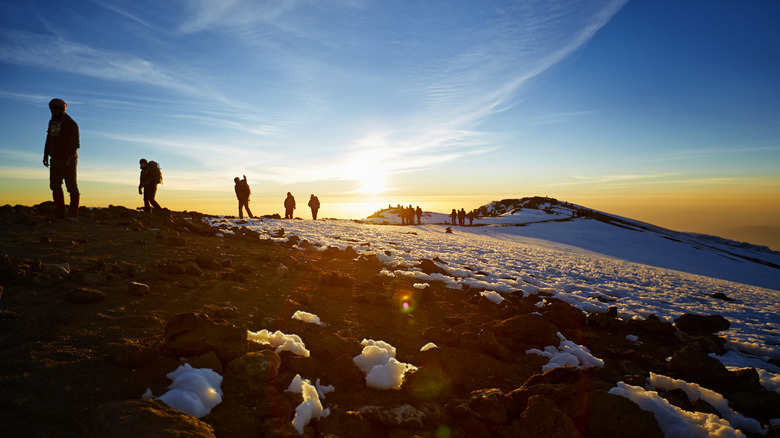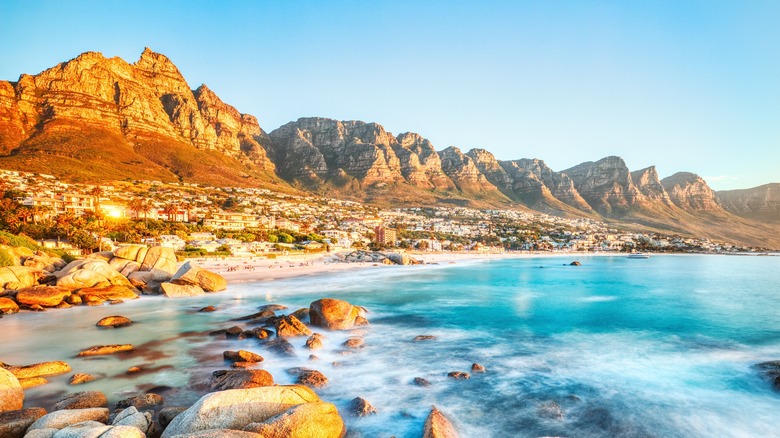Hikes Around The World You Can Climb For Ethereal Views (Instead Of Oahu's Stairway To Heaven)
During World War II, the U.S. Navy began constructing a radio station deep within the Haʻikū Valley, strategically leveraging the terrain of the Koolau Mountains nearby. This location provided a secure vantage point for naval communication over vast distances, nestled high and above the ground for protection. Access to the station required ascending a narrow and steep set of wooden stairs.
Eventually, the radio station was decommissioned, but the site became a magnet for hikers drawn to the allure of panoramic views across Oahu. The ascent, characterized by its steep and perilous nature, earned the nickname "Stairway to Heaven." The hike's popularity soared as tales of its thrilling adventure spread. Unfortunately, the influx of hikers brought challenges, as hikers disregarded the golden rules of Leave No Trace, prompting the U.S. Coast Guard to close the trail and public access in 1987. Despite the closure, rebellious souls continue to seek ways to experience the hike's breathtaking vistas, disregarding local law and customs—a major hiking mistake. In 2024 however, lawmakers decided to remove the steps permanently.
In light of concerns voiced by local and Native Hawai'ians regarding tourism's negative impact on the islands, outdoor enthusiasts have a responsibility to explore adventures elsewhere. Fear not, as there are countless legally accessible hikes offering equally mesmerizing views. Read on to discover some hikes around the world you can climb instead of Oahu's Stairway to Heaven for ethereal views.
Hallasan, South Korea
Hallasan, or Mount Halla, dominates the landscape of Jeju Island, located to the south of mainland South Korea. The majestic volcano towers at nearly 6,400 feet (1,950 m) above sea level, drawing in up to a million visitors every year. One of its most striking features is the crater lake nestled at its summit, named Baengnokdam Lake. Due to its elevation, the crater is often cloaked in clouds. However, brisk winds at this altitude swiftly disperse the clouds, offering intermittent glimpses of the serene blue-green waters and the picturesque surroundings of the island. Surrounded by swirling clouds, with fleeting bursts of sunlight illuminating the crater lake, hikers are transported to a heavenly realm.
Hallasan boasts five trails, two of which provide access to the summit. The most frequented route for summit seekers is the Songpanak Trail for the ascent and the Gwaneumsa Trail for the descent. The Songpanak offers a more gradual climb, easing the strain on hikers' muscles.
While many adventurers are eager to reach the summit to behold the mesmerizing crater lake while savoring a steaming bowl of ramyun, Hallasan also offers viewpoints along its trails. Noteworthy among these is Sara Oreum or Sara Crater Lake, situated along the Songpanak Trail — a stunning crystal-blue lake nestled in the volcano's flank. On the Gwaneusma Trail, Samgakbong Shelter provides unparalleled vistas of Jeju Island, Jutting out from the volcano, the shelter offers unobstructed panoramic views, allowing hikers to soak in the island's beauty.
Mount Kinabalu, Malaysia
Mount Kinabalu, towering majestically in the heart of Malaysian Borneo, beckons adventurers seeking ethereal views and unparalleled experiences. As the highest peak in Southeast Asia, standing at an impressive 13,435 feet (4,095 meters) above sea level, Mount Kinabalu is a symbol of pride for Malaysians and a magnet for hikers worldwide.
Embarking on the ascent of Mount Kinabalu is a multifaceted adventure. The trail leads hikers through a kaleidoscope of ecosystems, from lush tropical rainforests teeming with endemic flora and fauna to subalpine meadows adorned with vibrant blooms. Along the way, the diverse landscape offers glimpses of cascading waterfalls, crystal-clear streams, and dramatic rock formations, captivating the senses and invigorating the spirit. All the while, climbers share one staircase with those descending from the previous day's hike, making it important to follow hiking trail etiquette. At the summit of Mount Kinabalu, hikers are rewarded with awe-inspiring panoramas stretching as far as the eye can see. At dawn, as the first rays of sunlight pierce through the clouds, the summit comes alive with a kaleidoscope of colors, painting the sky in hues of gold and crimson and casting a spellbinding glow over the surrounding peaks and valleys.
For daredevils seeking an elevated thrill, the option of completing the via ferrata course adds an extra dimension to the adventure. Hikers can register to walk around the rim of Low's Peak, surrounded by the vast expanse of the sky, enhancing the ethereal ambiance of the hike.
Mount Fuji, Japan
Mount Fuji, Japan's iconic symbol of natural beauty, offers an enchanting hiking experience. Rising majestically to a height of 12,389 feet (3,776 meters) this stratovolcano stands as the highest peak in Japan. Every year, thousands of hikers from around the world flock to Mount Fuji, though the hiking season is limited due to inclement weather at the summit, leading the government to require hiking permits to control crowds.
The trek to Mount Fuji's summit unfolds in stages, with several well-established trails leading hikers through a diverse array of environments. Starting from the fifth station, where many climbers begin their ascent, the trail winds its way through rocky terrain, alpine meadows, and patches of snow, each step bringing hikers closer to the sky. Along the way, rustic mountain huts provide refuge and sustenance, offering weary climbers a chance to rest and refuel before continuing their journey. As hikers ascend higher, the landscape transforms, offering breathtaking vistas of the surrounding countryside and beyond. The ultimate goal for every climber is to witness the sunrise over the "land of the rising sun". As the sun rises over the horizon, the summit of Mount Fuji comes alive with a radiant glow, casting a spellbinding aura over the landscape and illuminating the path to the heavens.
After witnessing the sunrise, hikers begin their descent, a journey that often requires trekking poles. Mount Fuji's trails are covered in volcanic rock and ash, making for a slippery slide down the mountainside.
Mount Kilimanjaro, Tanzania
Mount Kilimanjaro is Africa's tallest peak, beckoning adventurers with its towering presence. Standing at a staggering 19,431 feet (5,895 meters) above sea level, this dormant stratovolcano in Tanzania demands a multi-day ascent, meaning hikers must meticulously choose the right backpack and gear for their journey and gear for their journey.
Hikers encounter a diverse range of ecosystems on their journey to the summit. The trek to the summit typically takes climbers through five distinct climatic zones, each with its own unique landscape and challenges. Starting from the lush rainforest at the mountain's base, hikers gradually ascend through heath and moorland, then onto the alpine desert, where the air grows thin and temperatures plummet. The final push to the summit takes climbers through the barren lunar landscape of the Arctic zone, where the only signs of life are the occasional hardy plant clinging to the rocky slopes.
As climbers ascend higher, the air grows thinner, making each step more challenging than the last and putting hikers at risk of altitude sickness. Yet, with proper acclimatization and determination, reaching the summit is within reach for those willing to push their limits. At the summit, climbers are rewarded with awe-inspiring panoramic views stretching across the vast African plains below. On clear days, the summit offers a breathtaking view where one can see the curvature of the Earth, as some lucky users on Quora Digest attest, imparting a sense of gazing upon the Earth from the heavens above.
Table Mountain, South Africa
Table Mountain, overlooking the vibrant city of Cape Town, South Africa, stands at an impressive height of 3,563 feet (1,086 meters). Hiking Table Mountain offers a diverse range of trails suitable for hikers of all skill levels, from leisurely strolls to challenging ascents. One of the most popular routes is the Platteklip Gorge Trail, which ascends directly to the summit, offering spectacular views of the city below. For those seeking a more adventurous experience, the India Venster Trail provides a thrilling ascent along the mountain's eastern face, complete with scrambling sections, resembling some of the most dangerous hiking spots in the world.
Hiking Table Mountain can in fact be dangerous. The mountain is notorious for its rapidly changing weather conditions, which can include sudden gusts of wind, thick fog, and even snow during the winter months. Additionally, the rocky terrain and steep cliffs pose hazards for inexperienced hikers, with falls and injuries being a potential risk. The hike to the summit also features steep switchbacks and exposed sections with sheer drop-offs on either side, mimicking the treacherous element of Oahu's Stairway to Heaven.
Reaching the summit of Table Mountain is a momentous achievement, rewarded by sweeping panoramic views of Cape Town, Table Bay, and the surrounding coastline. On clear days, it's possible to see as far as Robben Island and the Cape Peninsula, providing a truly unforgettable vista that leaves hikers in awe of the natural beauty that surrounds them.





